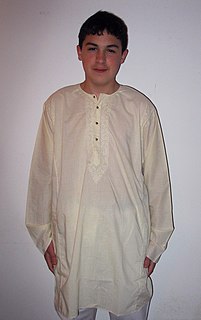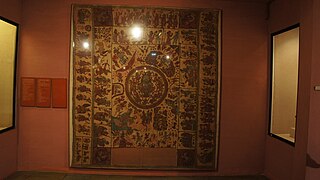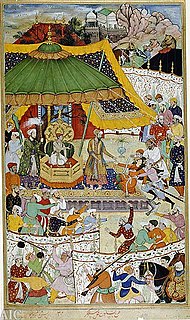Related Research Articles

Muslin is a cotton fabric of plain weave. It is made in a wide range of weights from delicate sheers to coarse sheeting. It gets its name from the city of Mosul, Iraq, where it was first manufactured. In the 17th and 18th centuries Dacca in Bengal was regarded as producing the finest muslins.

A kurta is a loose collarless shirt worn in many regions of South Asia, and now also worn around the world. Tracing its roots to Central Asian nomadic tunics, or upper body garments, of the late-ancient- or early-medieval era, the kurta has evolved stylistically over the centuries, especially in South Asia, as a garment for everyday wear as well as for formal occasions.

Bandhani is a type of tie-dye textile decorated by plucking the cloth with the fingernails into many tiny bindings that form a figurative design. The term bandhani is derived from the Sanskrit verbal root bandh. Today, most Bandhani making centers are situated in Gujarat, Rajasthan, Sindh, Punjab region and in Tamil Nadu where it is known as Sungudi. Earliest evidence of Bandhani dates back to Indus Valley Civilization where dyeing was done as early as 4000 B.C. The earliest example of the most pervasive type of Bandhani dots can be seen in the 6th century paintings depicting the life of Buddha found on the wall of Cave 1 at Ajanta. Bandhani is also known as Bandhej Saree, Bandhni, Piliya, and Chungidi in Tamil and regional dialects. Other tying techniques include Mothra, Ekdali and Shikari depending on the manner in which the cloth is tied. The final products are known with various names including Khombi, Ghar Chola, Patori and Chandrokhani

Rahon is a city and a municipal council in the district Shaheed Bhagat Singh of the Indian state of Punjab. Rahon is in Doaba region of Punjab. Doaba also known as Bist Doab, is the region of Punjab, India that lies between the Beas River and the Sutlej River.

An uttariya is a loose piece of upper body clothing. It is a single piece of cloth falls from the back of the neck to curl around both arms and could also drape the top half of the body. An Uttariya is similar to a veil, a long scarf and shawl.

Kota Doria or Kota Doriya is the name of a light woven fabric made of tiny woven squares (khat) which is still handwoven on traditional pit looms in Kaithoon near Kota in Rajasthan and in some of the surrounding villages. Kota Doriya Sarees are made of pure cotton and silk and have square like patterns known as khats on them. The chequered weave of a Kota sari is very popular. They are very fine weaves and weigh very little.

Ghagra choli,, is a type of ethnic clothing for women from Indian Subcontinent, notably in the Indian states of Rajasthan, Gujarat, Madhya Pradesh, Uttar Pradesh, Bihar, Haryana, Punjab, Himachal Pradesh, Uttarakhand, Jammu and Kashmir, as well as in the Pakistani provinces of Punjab and Sindh. In Punjab, the lehenga is traditionally worn with a kurti. It is a combination of the gagra or lehenga and the choli (blouse), however in contemporary and modern usage lehenga choli is the more popular and widely accepted term by fashion designers, trend setters, and boutiques in South Asia, since ghagra is synonymous with the half-slip worn as an undergarment below the sari.

Kalamkari is a type of hand-painted or block-printed cotton textile produced in Isfahan, Iran, and in the Indian state of Andhra Pradesh. Only natural dyes are used in Kalamkari, which involves twenty-three steps.
Bafta is a Persian word meaning woven and is a plain-woven textile. Bafta is a kind of calico, initially made in India. It was produced in Bharuch, previously known as Broach, a city in Gujarat, India. Bafta is a coarse, cheap woven long length but of narrow width material, made chiefly of cotton. Bafta was a generic term for a plain calico of Gujarat especially of Broach and Navsari.
Khasa was a high-quality variety of calico cloth that was manufactured and used for clothing in the Mughal Empire.

Piece goods were the textile materials sold in cut pieces as per the buyer's specification. The piece goods were either cut from a fabric roll or produced with a certain length, also called yard goods. Various textiles such as cotton, wool, silk, etc., were traded in terms of piece goods. The prices were determined as per the fabric quality.
Muqayyash is an ancient craft of brocade embroidery work with silver yarn on silk cloth from Gujarat, India. The silk is ornamented with a silver stripe pattern. Muqayyash is one of the Mughal period silk cloth, and it is recorded in Ain-i-Akbari. The muqayyash was one of the fine brocades of Gujrat among a tus, daraibaf, kurtahwar. It was one of the expensive cloths of that time, priced at 2-50 gold Muhr.

Mughal karkhanas were the manufacturing houses and workshops for craftsmen, established by the Mughals in their empire. Karkhana is a Hindustani language word that means factory. These karkhanas were small manufacturing units for various arts and crafts as well as for the emperor's household and military needs. karkhanas were named and classified based on the nature of the job. For example, 'Rangkhana' and 'Chhapakhana' were for textile dyeing and printing work. The term 'tushak-khana' was used to describe workshops that made shawls and embellished them with embroidery or needlework. Imperial or Royal Karkhanas were for luxury goods and weapons. The karkhanas were the place for various production activities and also for the exploration of new techniques and innovations. Some operations such as weaving, embroidery work, and brocade work were often done under one roof, resembling an integrated assembly line.
Chautar or Chaotaer is an old cotton fabric of the Mughal period. The chautar was a mulmul variety, and the finest mulmul was termed as ''Mulmul Shahi'' in Hindi and Persian languages. It was produced in Eastern India. Way back, Chittagong was exporting this cloth. Conceivably then cloths were produced in smaller pieces only since the Chautar is described as a piece good. It has been recorded with specific dimensions, i.e., length 12.44 meters and width 77.75 centimeters. Chautar was compared with sansuo, which was a three shuttle cloth, type of fine cotton variety produced at Songjiang.

Panchtoliya was an old cotton cloth of the Mughal period. The Panchtoliya was very light in weight and used for the veil. It was weighing only 2-5 tola per piece. The credit of Panchtoliya goes to the Mughal empress Nur Jahan. She was very fashion enthusiastic, encouraged, and introduced many styles and varieties of cloths of her interest. Few examples are Panchtoliya, badla, kinari, and Dudami weighing just two dams. Nur Jahan is also credited for specific dresses. For instance, nurmahali for the wedding is one of them.
Alacha is a lightweight striped cloth made primarily of silk, sometimes cotton, or a mixture of both. The stripe pattern was evident on both sides of the fabric. A typical length of Alacha is five yards. It was produced in various parts of India, for example Baikunthpur, Bihar. The cloth was popular in use for female garments such as dupattas (odhni), veils, and petticoats.
Adhotar was a coarse variety handloom cloth with a loosely woven structure. Adhotar was a cloth of locals in the early 19th century. It was one among various other Indian handloom fabrics such as khaddar, garha, dres, and Khasa.
Mahmudi, or Maḥmūdī, was a fine cotton variety cloth produced in India.
Katan was a thin silk cloth. It was made of double twisted yarns of pure silk yarns in warp and weft both.
Dorea was a type of striped or check patterned cloth made in the Indian subcontinent. The continued striped Dorea was a simplest form of Dorea.
References
- 1 2 Sangar, S. P. (1965). "FEMALE COSTUMES IN THE SIXTEENTH AND SEVENTEENTH CENTURIES (as reflected in the contemporary Hindi literature)". Proceedings of the Indian History Congress. 27: 243–247. ISSN 2249-1937. JSTOR 44140630.
- ↑ Jain, Simmi (2003). Encyclopaedia of Indian Women Through the Ages: The middle ages. Gyan Publishing House. p. 197. ISBN 978-81-7835-173-5.
- 1 2 3 Pawar, Appasaheb Ganapatrao; University, Shivaji (1971). Maratha History Seminar, May 28-31, 1970: Papers. Shivaji University. p. 51.
- ↑ Sharma, Gopi Nath (1968). Social Life in Medieval Rajasthan, 1500-1800 A.D.: With Special Reference to the Impact of Mughal Influence. Lakshmi Narain Agarwal.
- ↑ Congress, Indian History (2004). Proceedings. Indian History Congress. p. 544.
- ↑ Panjab University Research Bulletin: Arts. The University. 1982. p. 90.
- ↑ Jain, Simmi (2003). Encyclopaedia of Indian Women Through the Ages: The middle ages. Gyan Publishing House. p. 197. ISBN 978-81-7835-173-5.
- ↑ Congress, Indian History (1967). Proceedings. Indian History Congress. p. 243.
- 1 2 Srivastava, Ashok Kumar (1981). Hindu Society in the Sixteenth Century: With Special Reference to Northern India. Milind. p. 118.
- ↑ Sharma, Gopi Nath (1968). Social Life in Medieval Rajasthan, 1500-1800 A.D.: With Special Reference to the Impact of Mughal Influence. Lakshmi Narain Agarwal. p. 154.
- ↑ Shobha, Savitri Chandra (1996). Medieval India and Hindi Bhakti Poetry: A Socio-cultural Study. Har-Anand Publications. p. 96.
| Look up tansukh cloth in Wiktionary, the free dictionary. |



